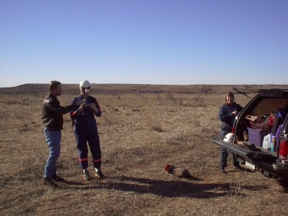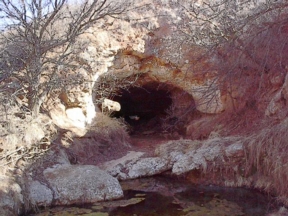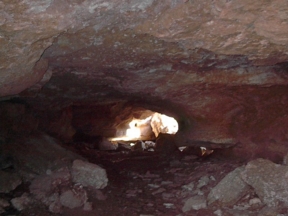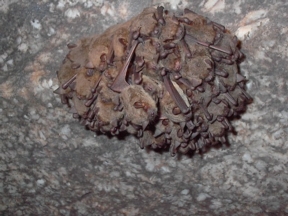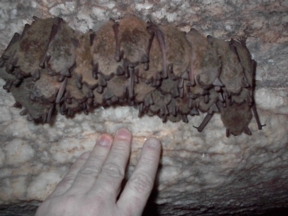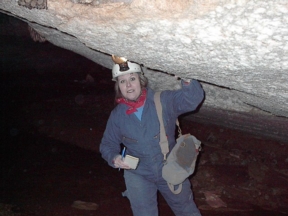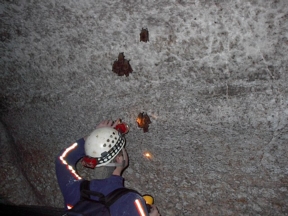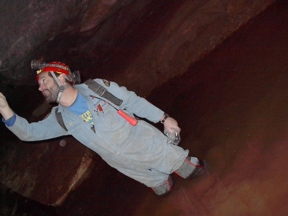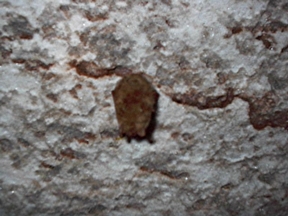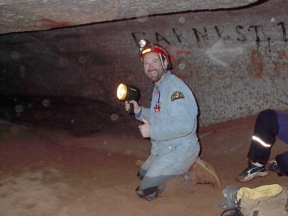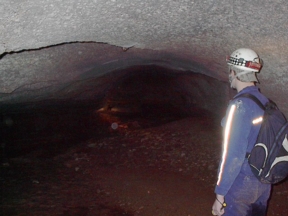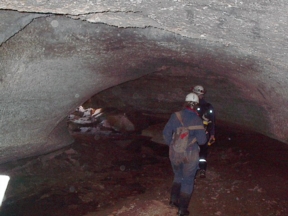Getting Ready for going in South Jester
1. The third Saturday of February - on average, the coldest weekend of the winter - time for Oklahoma Bat Count. (Though it wasn't even cold this trip - mid 60's!) Teams from Central Oklahoma Grotto (COG) split into three groups and divided the western part of the state for a bat population count.
Entrance to South Jester
2. The southwest team had the Jester cave complex for the count. Seven people converged on this longest gypsum cave of Oklahoma to see how our little furry flying friends are doing. These bats hibernate (sleep away the winter) rather than migrate (to places like Mexico). They eat all summer long and grow fat to allow them to sleep away the winter in a cold cave.
Jessie James's Hiding Room in Jester
3. You have to be quiet and try not to disturb the bats while they sleep. They store just enough fat to last them the winter. When they wake, they wake hungry. If they wake up now, there aren't too many insects flying around for them to eat. So they will go back to sleep...but too many awakenings will use up their fat buildup and they will die before spring.
Larry in Jessie James's Hiding Room
4. Larry, Lil, Duane, and Dale took the South Entrance for the count and were going to meet John Talbot, John VanDyke, and others who were doing North Jester main bat rooms. Dale was feeling under the weather so was the main driver but opted out of going in the caves this year. Smart move... you don't want to get sick in a cave and have others help you out... the motto: be safe, be smart - Don't cave if you don't feel up to it!
The reason we're here - the Bats
6. It all depends on the temperature inside the cave. The colder the cave, the deeper in a sleep the bats are. The temperature in this cave location was 46 degrees. These bats are Myotis velifer, which we just call Myotis (common cave bat in this area). They group in clusters like this small one to giant mats stretching across a ceiling.
A hand for comparison of size of these bats.
7. They hold on to the ceiling with little claws on their feet. Counting them is sometimes a challenge as they are all piled on top of each other, crammed into little cracks, or just so many, it's easy to lose count. How many do you see here? (answer on #8)
Lil is the recorder for our trip
8. The picture is misleading...you can't see all the bats on the bottom. There were thirty bats here in that mini cluster. The way a bat count works is one person is a recorder, and the others are the counters. The recorder's job is to write down the numbers called out by the counters. Sounds easy? It's not... numbers flying from different people, special codes have to be written down for what kind of bat, temperature readings, water readings, rock temperature readings, time, all have to be recorded.
Larry counts a couple of small groups
9. The counter meanwhile is searching the walls, ceiling, cracks, (everywhere but the floor) for bats. When they find a group or individual they call out the number. For myotis, the counter would just say the number found. (example above: 1, 4, 2) For a pip, the counter would say the number and the letter P (ex: 1P) And for a Long Ear, it would be the number followed by LE (ex: 4LE)
Condensation collects on these bats
10. Many bats usually hang out over water. The water acts as a buffer for the temperature and tends to keep it fairly the same throughout the winter. Above, these bats have droplets of water forming on their backs. These bats actually seem to sparkle when your light shines on them. Whereas we would be pretty miserable being wet trying to sleep, it doesn't seem to affect these guys.
What happens when Lil takes a picture!
11. The counter can't always be comfortable doing the count. We wade through 40 degree water, mud up to our knees (and above), very rocky uneven floors, low crawling passages, and the like. It's a cave, a wild cave, not tamed with sidewalks, lights, paths, elevators, and the like. You walk, stop, look up, search, look down, walk, etc... nothing like smacking your head upside a giant rock (even with helmet), crawling though mud to get to the next passage, or slipping and falling into a pool of very cold water!!!
A Pip (Pipistrellus subflavus)
12. Later in the cave the water disappears for awhile under some rock but there is a long low bend over tube leading away on a higher level. That's where the team has to go next. The temperature rises in this passage up to 56 degrees. Too warm for Myotis but just right for a smaller bat to hang out. This little reddish brown bat is commonly called a Pip. (Pipistrellus subflavus - that's the science name) They prefer a warmer area than the myotis and this long tub had a small collection hanging out.
D with his 1,000,000 candle power light
13. As you can see from the picture above, Jester cave has been vandalized quite a bit. It is against Oklahoma state law to deface (mark up) and harm a cave in Oklahoma. A lot of these are kids coming in for parties, campouts in the cave, exploring the darkness, etc... what they don't realize is that they are violating the law and hurting the cave system. They usually don't have permission from the landowner to be on the land (trespassing), they don't know that they are disturbing the bats and other cave life. Writing graffiti on the wall is not only ugly but also against the law. Some take out parts of the cave as a souvenir yet that too is against the law. If you want to cave, get a hold of a local cave group and learn the right way to go about this unique sport.
Jester turns commercial cave with light!!
14. Back to the Jester bat count. When we reached the end of the low tube, D brought out his new super light he got for Christmas. One million candle power, it lit up the cave like a commercial cave. It worked particularly well in the giant dome rooms where the ceiling is about 20 feet tall, and a radius of about 20 feet. When we came back though to this big room, lighting it up revealed that we had missed a bunch of bats our regular lights could not pick up. (did we mention it is very dark inside a cave?) <grin> It was a little different to see every detail inside the cave. Unfortunately, a flashlight this big uses a ton of battery power and after only about 15 minutes, it ran down... sigh... but it was pretty cool!! Now to find a way to put it on a helmet!!
Time to leave
15. The end of the line, this section of the cave is finished and it's a trek back to the entrance and on to another section of the cave for more bat counting. We were to meet the other crew and help them with the main bat rooms in the Northern part of the cave. But alas... we found some trouble...
Oops...locked in with no escape possible?!?!!!
16. There was only one set of keys we got from the landowner. So the other team let us in our section, closed the gate and acted like they locked the gate behind us but leaving it unlocked so we could get out and join them. Then the other team went to the other section to begin their part of the count. Alas.. when we got to the gate, it was locked nice and tight. It took over an hour to walk to the other set of caves, find the bat crew there, retrieve the key, and get the car out... sigh..
17. But we finally did get out of there. We met the other team as they were coming out the exit of their section. We took over and did an entrance called Homestead where we commonly find long ear bats and a mini cave on the property called Wired Cave. We found some long ears (pictures on page 2) but Wired Cave was a bust with only a few Pips and 5 myotis. We then had to pack it all up and head up north of Woodward, Oklahoma for a special birthday party of a friend of our club. Mrs. Betty Selman had invited all of us to a special 80th birthday party (see page 3 report).
18. Final Counts (Updated 4/13/02)
| Myotis Veliper (Cave Bat) |
12,
561
|
| Corynorhinus Townsendi Palesens (Big Eared) |
12
|
| Pipistrellus Subflavus (Pipistrel) |
56
|
|
--------
|
|
| Total For Jester Bat Count |
12,629
|
